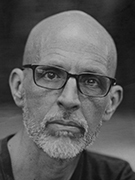
Patterns and animation with Python in DrawBot
with
Maurice Meilleur
About as long as people have been making objects and marks, we’ve also been making patterns. They’re ubiquitous in surface design, clothing and other textiles, branding and packaging, architecture, and environmental graphics and ornamentation. Some of the most fascinating patterns give the impression of movement—and patterns that *really* move are increasingly common in a world of screen-based media.
Writing code is a great way to explore pattern and motion, to break patterns down into design spaces and elements and instructions for how to arrange them in and with each other and move them around. You can take a few shapes and some simple directions and conditions and cover a virtual surface—and quickly make countless variations of the pattern to better understand what you’re making and explore new ideas, directions, and possibilities. Small changes—even mistakes!—in the code can lead to outcomes that might be even better than what you’d originally planned.
In this course, you’ll work in the free and user-friendly application DrawBot for the Macintosh OS. You should have some previous experience writing code in Python; any introductory course or workshop (such as Type@Cooper’s Python for Visual Designers) should be sufficient.
Weekly course meetings will include short tutorials and code-along demos with shared sample files. Each week we’ll look at one or two examples of patterns, use them to talk about concepts and methods in pattern-making, and recreate them together with code. We’ll start with static designs and introduce animation methods as we go. There will be prompts for you to explore further what you learn between sessions, and a Slack workspace for more feedback and q/a.
DrawBot allows you to produce high-quality vector art that you’ll be able to save as single images (or animation frames) in .jpg or .png formats, or as animated .gifs or .mp4 videos, as end products or for further processing in other applications. You’ll also be able to generate .svg outlines to send to pen or cutting plotters, and .pdf files for print.
Many of the methods and concepts we’ll cover in the course you can extend to other coding languages and environments, and to other drawing and animation applications. And if you’ve ever been interested in generative and computational design, coding patterns and animation is a great introduction. I hope you can join us!
Materials/access:
- Mac with MacOS v10.9 or higher
- stable internet connection (for Zoom and Slack)
- DrawBot application (free download at https://www.drawbot.com/content/download.html)
- Zoom desktop application
- sketchbook for taking notes and planning
Banner image adapted from Julio Le Parc, Mutación de Formas (1959)
About Maurice Meilleur

Maurice Meilleur is a recovering political theorist turned graphic designer and design researcher and writer. He completed a PhD in political theory from Indiana University Bloomington in 2004, and earned his MFA in graphic design from the University of Illinois at Urbana-Champaign in 2015. He’s an assistant professor of graphic design at Iowa State University in Ames, Iowa, where he teaches and studies typography and generative design. He has contributed numerous type and book reviews to Typographica and Fonts in Use. He’s writing a book on Jurriaan Schrofer’s constructed scripts, and he’s presented his research at Robothon, ATypI, TypeCon, the Cooper Union, and the Letterform Archive. Maurice explores digital drawing and animation using Python and Drawbot as part of a larger investigation into typographic representation and algorithmically-defined formal systems.
